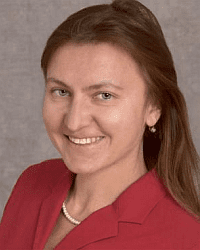
Kristina Denisova, PhD
Basic Information
Title: Associate Professor
Area: Cognitive Psychology, Neuroimaging, Autism
PhD: Rutgers University, 2010
EMail: Kristina.Denisova@qc.cuny.edu
Office: Science Building A308
Office Phone: 718-997-3212
Lab Location: Denisova Lab, Science Building E311
Lab Phone: 718-997-3219
Website:
Biography
Our lab’s mission is to understand the neural systems that subserve sensation and perception and how their impairment may contribute to childhood neurodevelopmental disorders, in particular Autism Spectrum Disorders (ASD). I look forward to mentoring Queens college MABN and PhD students in advanced neuroimaging techniques, including functional and structural Magnetic Resonance Imaging (MRI), and to help ensure competitive success for all trainees. I graduated magna cum laude from NYU with an Honors degree in Psychology (sponsor: Marisa Carrasco, PhD). My work has been recognized with national awards (1st prize for research from Psi Chi; member of Phi Beta Kappa; a SFARI Investigator – an Award for highly novel, groundbreaking studies in autism). I obtained my PhD in Cognitive Psychology from Rutgers University (sponsor: Dr. Manish Singh, PhD), followed by exceptional training in MRI during my NIMH T32 Fellowship, including scanning of children with ASD, signal processing and data analysis (with Brad Peterson, MD) at Columbia University, where I also developed a research program in children with autism and those at risk.
Our lab’s discovery of the earliest quantitative markers of atypical development to date, as early as 1-2 months after birth, is now at the top ~5% (Altmetric). I am now leading several research projects, including with funding by the NIMH with the aim to discover the origins of autism in the 1st year of life. In addition to research with human subjects, we work with Big Data and use computational techniques to solve new problems in the field. A number my PhD- and Masters-level trainees published first-author papers and hold full-time jobs in the academia, and some in the industry as well. I invite interested students to inquire about current opportunities in our group.
Publications
- Denisova, K. (2021). Genetic vulnerability of exposures to antenatal maternal treatments in 1-2 mo-old infants. Infancy.
- Aston, S., Denisova# , K., Hurlbert, A., Olkkonen, M., Pearce, B., Rudd, M., Werner, A., & Xiao, B. (2020). Exploring the determinants of color perception using #thedress and its variants. Perception, 49, 1235-1251. doi:10.1177/0301006620963808. PMID: 33183137 # denotes joint First author
- Denisova, K. (2019). Failure to attune to language predicts autism in high risk infants. Brain and Language, 194, 109-120. doi: 10.1016/j.bandl.2019.04.002. PMID: 31133435
- Denisova, K. (2019). Age attenuates noise and increases symmetry of head movements during sleep resting-state fMRI in healthy neonates, infants, and toddlers. Infant Behavior and Development, 57, 101317 (invited contribution: special issue on Infant Imaging). doi: 10.1016/j.infbeh.2019.03.008. PMID: 31102945
- Denisova, K. (2019). Neurobiology, not artifacts: Challenges and guidelines for imaging the high risk infant. NeuroImage, 185, 624-640 (invited contribution: special issue Imaging Baby Brain). doi: 10.1016/j.neuroimage.2018.07.023. PMID: 30010009
- Zhao, G., Walsh, K., Long, J., Gui, W., Weihua, Denisova*, K. (2018). Reduced structural complexity of the right cerebellar cortex in male children with autism spectrum disorder. PLoS ONE. doi: 10.1371/journal.pone.0196964. PMID: 29995885 # denotes Senior author
- Denisova, K. & Zhao, G. (2017). Inflexible neurobiological signatures precede atypical development in infants at high risk for autism. Nature Scientific Reports, 7: 11285. doi: 10.1038/s41598-017-09028-0. PMID: 28900155
- Denisova, K., Zhao, G., Wang, Z., Goh, S., Huo, Y., & Peterson, B. (2016). Cortical interactions during the resolution of information processing demands in autism spectrum disorders. Brain and Behavior. doi: 10.1002/brb3.596. PMID: 28239517
- Torres# , E.B. & Denisova# , K. (2016). Motor noise is rich signal in autism research and psychopharmacological treatments. Nature Scientific Reports, 6:37422. doi:10.1038/srep37422. PMID: 27869148 # denotes joint First author
- Zhao# , G., Denisova# , K., Sehatpour, P., Long, J., Gui, W., Qiao, J., Javitt, D.C., Wang, Z. (2016). Fractal analysis of the structural complexity of subcortical gray matter structures in schizophrenia. PLoS One, 13, 11(5):e0155415. doi: 10.1371/journal.pone.0155415. PMID: 27176232 # denotes joint First author
- Denisova, K., Feldman, J., Su, X., & Singh M. (2016) Investigation of shape representation using sensitivity to axis and part based transformations. Vision Research, 126: 347-61 (invited contribution: special issue on Gestalt perception). doi: 10.1016/j.visres.2015.07.004. PMID: 26325393
- Denisova, K., Kibbe, M. M., Cholewiak, S.A., & Kim, S-H. (2014). Intra- and intermanual curvature aftereffect can be obtained via tool-touch. IEEE Transactions on Haptics, 7(1), 61- 66. doi: 10.1109/TOH.2013.63. PMID: 34845746
- Denisova, K., Singh, M., & Kowler, E. (2006). The role of part structure in the perceptual localization of a shape. Perception, 35(8), 1073-1087. doi: 10.1068/p5518. PMID: 17076067
- Carrasco, M., McElree, B., Denisova, K., & Giordano, A. (2003). Speed of visual processing increases with eccentricity. Nature Neuroscience, 6, 699-700. doi: 10.1038/nn1079. PMID: 12819786

